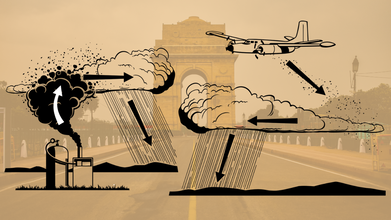- Health Conditions A-Z
- Health & Wellness
- Nutrition
- Fitness
- Health News
- Ayurveda
- Videos
- Medicine A-Z
- Parenting
- Web Stories
You’re Most Likely To Live Next To A Psychopath In These US States

Christian Bale as Patrick Bateman in the film ‘American Psycho’ @Alamy
How any times have you watched a true crime documentary and wondered, “What kind of person could actually do that?” Well, science may have just brought us a step closer to the answer—and the location. A new eye-opening study has mapped out where in the United States you're most likely to encounter people with dark personality traits like narcissism, psychopathy, and sadism. And no, it’s not just Hollywood dramatizing the ‘evil neighbor’ narrative, some states really do have higher concentrations of individuals with what psychologists call the “Dark Factor of Personality,” or “D.”
Turns out, the environment we live in marked by things like poverty, corruption, inequality, and violence could actually shape how likely we are to exploit or harm others for personal gain. So, if you’ve ever felt like your city breeds a little more chaos than kindness, you might not be imagining it. The results? Both fascinating and unnerving.
A groundbreaking study published in Proceedings of the National Academy of Sciences (PNAS) analyzed data from nearly 1.8 million respondents worldwide—including over 144,000 Americans—to identify where "dark" personality traits like psychopathy, narcissism, and Machiavellianism are most prevalent. The researchers found that horrid societal conditions—high poverty, inequality, corruption, and violence are closely linked to these darker traits.
What Are Some Dark Personality Traits?
Psychologists refer to these harmful traits collectively as the “Dark Factor of Personality”, or “D”. This umbrella concept captures the underlying tendency toward aversive behavior manipulation, exploitation, even enjoyment of others' suffering. Unlike the well-known “dark triad” (psychopathy, narcissism, Machiavellianism), “D” integrates these tendencies into a single measurable dimension.
Researchers linked high D scores with self-serving behaviors and the belief that self-interest often superseeds moral or societal responsibilities. Crucially, they discovered that social and economic hardships tend to foster these personality traits over time
While analyzing data at the U.S. state level and correlating it with FBI homicide rates, Justice Department corruption convictions, and Census Bureau statistics, the researchers revealed stark geographical patterns. States with higher crime, corruption, and economic disparity tend to have higher average D scores. Among the highest-ranked states:
- Nevada tops the list with a D score of 2.26/5
- New York (2.24)
- Texas (2.22)
- South Dakota (2.22)
In contrast, the safest states in terms of low dark personality prevalence include:
- Vermont (1.96)
- Utah (2.03)
- Maine (2.04)
- New Hampshire, Oregon, and Alaska
Though differences may seem minor numerically, they are statistically significant across large populations.
Role of Sociocultural Environments in Shaping Personality
One of the study’s most compelling insights is how personality is not merely inherited. Lead co-author Ingo Zettler explains that living under corrupt, unequal, or violent conditions teaches people to look after themselves first.
This adaptation may serve as a survival mechanism in harsh environments, distrust, aggression, and self-centeredness offer competitive advantages. Urban areas like New York and Las Vegas, with extreme resource competition, often amplify these traits.
State Profiles
Nevada, New York, Texas, South Dakota
Nevada’s D score of 2.26 tops the nation with analysts suggesting that both systemic issues and the transient, high-stakes nature of urban hubs like Las Vegas amplify dark traits. New York and Texas closely follow both states face stark inequality and urban density.
South Dakota’s inclusion challenges stereotypes, showing that inequality and lack of resources, not just urban stress, can drive 'darker' behavioral tendencies.
Vermont, Utah, Maine, New Hampshire, Oregon, Alaska
Vermont’s low score (1.96) positions it as the least likely to harbor dark personalities. These states share lower poverty rates, strong community cohesion and fewer corruption issues, creating environments that foster trust and cooperation.
While the link between adverse conditions and dark traits is moderate, its social cost is substantial. Traits like aggression, exploitation and cheating contribute to systemic challenges from governance issues to workplace toxicity .
Zettler emphasizes that small improvements in reducing corruption and inequality can yield large societal benefits by stemming the growth of dark personality traits
Researchers acknowledge limitations. The study doesn't account for migration—a psychopath in New York may have grown up elsewhere. Also, while personality evolves, genetic factors and early childhood experiences play significant roles. The findings highlight personality as malleable, shaped significantly by social context.
This extensive data reveals that the "dark factor" is not a rarity it lingers in communities shaped by inequality, corruption and violence but the study also offers hope.
Men Need To Work Twice As Hard As Women To Beat Heart Diseases: Study Reveals

(Credit-Canva)
Heart diseases affect women and men differently. This fact has been explored and understood by many different studies. A recent study published in Nature Cardiovascular Research shows that men have to work twice as hard to beat heart diseases than women. While previously, researchers have found that women are at a higher risk of dying from a heart disease. For instance, a study published in the Journal of Health Economics and Outcomes Research, pointed out that a lot of it is due to doctors not taking gender and sex differences into account.
The new study however, points that women may not need to exercise as much as men to gain significant protection against coronary heart disease. Why is there such a big difference in beating the odds for men and women?
How Is Heart Health Different for Men and Women?
The research comes from an observational study of over 85,000 UK adults tracked for about seven years using fitness tracker data. The research clearly shows that men and women need different amounts of exercise to keep their hearts safe. Women seem to get more "bang for their buck" when they exercise:
For Preventing Heart Disease:
Women who did about four hours of moderate exercise each week (think brisk walking) lowered their risk of getting heart disease by about 30%. Men on the other hand needed almost double that time—around eight hours a week—to get the same 30% protection!
If You Already Have Heart Disease:
The difference is even bigger here. Women who had previous heart problems saw their risk of death drop by three times compared to women who didn't exercise. In men with similar heart histories needed much more weekly exercise to get a similar life-saving benefit.
In general, active women had a 5% greater reduction in heart disease risk than active men. This shows that being active is great for everyone, but women might have a slight natural advantage.
What is Moderate Exercise?
It's important to know what kind of exercise we're talking about. Moderate exercise is any activity that gets your heart pumping but doesn't make you feel totally wiped out. Examples include a brisk walk, gardening, or a fast bike ride. Vigorous exercise is when you push your body harder, causing a bigger jump in your heart rate. Think running, swimming laps, or hiking up a steep hill.
The study confirms that any amount of activity is better than none for your heart. Researchers found a clear connection: the more you move, the lower your risk of heart disease and death.
Do Hormones Affect Your Heart Health?
Why do women get such a great benefit with less effort? The study authors point to two main reasons tied to the body's natural makeup:
Hormones
Women have higher levels of the hormone estrogen. Estrogen is thought to help the body burn fat more effectively during exercise. This could be one reason why women see better heart benefits.
Muscle Types
Men tend to have more "fast-twitch" muscles, which are great for quick, powerful movements (like sprinting). Women usually have more "slow-twitch" muscles, which are better for endurance and working efficiently for longer periods. This more "efficient" muscle type might make workouts more beneficial for heart health in women.
Should Doctors Tailor Treatment According To Gender?
It's also crucial to know that heart disease affects men and women differently. Doctors point out that women often develop heart problems later in life and, sadly, are sometimes less likely to get the standard tests and care for heart issues that men receive.
The findings suggest that public health advice should be personalized and recognize that men and women have different needs.
The most important takeaway is this: Talk to your doctor before you start any new fitness plan. Your perfect exercise routine depends on your current health, fitness level, and any existing medical issues. There is no one-size-fits-all plan!
How Does Cloud Seeding Works In Curbing Air Pollution And Its Toxic Impact On Health?

Credits: Canva and Wikimedia Commons
The Delhi government is all set to conduct its first ever environmental experiment known as artificial rain on Wednesday. Chief Minister Rekha Gupta confirmed that Delhi will experience its first artificial rain on October 29. Many have predicted that this will improve the air quality in the national capital and also bring down the pollutants level, including the PM2.5 in the year. The levels have gone up since Diwali, and has recorded the highest in the last five years, says report.
As per health experts and doctors, the poisonous air can impact human health in many ways, including:
- Respiratory issues
- Asthma
- Bronchitis
- COPD
- Spiking the risk of cardiovascular disease
- Heart attack
- Heart strokes
- Lung cancer
- Premature death in infants and children
Children are most vulnerable to the negative impact of toxic air. Furthermore, the high levels of pollution could also lead to other systemic issues, including affecting the brain, skin, and other organs.
How Does Artificial Rain Work?
Artificial rain will be orchestrated through cloud seeding. This is a project led by IIT Kanpur in coordination with the India Meteorological Department (IMD). This will artificially trigger rainfalls over parts of Delhi.
As per experts, this is a bold initiative and is a scientific attempt to tackle the city's recurring pollution problem. This is a weather modification technique that enhances rainfall by encouraging condensation in clouds. It does not create rain, but increases the likelihood of rainfall from existing moisture-packed clouds.
Chemicals are used as seeding agents, including silver iodide, potassium iodide, salt, and dry ice or frozen CO2. These agents are released into the air with the help of cloud seeding aircraft, and rockets.
What happens then is the silver iodide helps in formation of ice crystals in cold clouds and allows the water to cling to them. The precipitation increases and droplets grow larger, eventually leading to a rainfall.
Can Artificial Rain Put Delhi's Pollution Problem To A Rest?
As per experts, its benefit could only be measured based on the amount of moisture present in cloud, wind, and temperature conditions, along with timing and the type of seeding, the size of the area that is being seeded. There are studies that say the benefits of cloud city could have a huge range, from a 5 per cent to 20 per cent spike in precipitation.
The process has been successfully implemented in China, the UAE and parts of the United States in order to increase rainfall.
As per experts, if the artificial rain is implemented well, it could wash down particulate matter or PM2.5 and PM10. However it is to be noted that this is only a temporary solution to improve AQI, but nevertheless, it can help with breathing and other respiratory issues people are facing.
Delhi's AQI As Of 28 October, 6.30 AM
- As per the National Air Quality Index, as of 6.30 am, Anand Vihar recorded an AQI of 348, putting it under the 'very poor' category.
- Kashmere Gate recorded AQI of 299, under 'poor' category
- Rohini recorded an AQI of 346, under 'very poor' category
- Nangal Thakran, an area in Delhi recorded an AQI of 401, placing it under 'severe' category
- ITO recorded an AQI of 336, placing it under 'very poor' category
- Nazafgarh recorded an AQI of 307, placing it under 'very poor' category
- Azadpur recorded an AQI of 351, placing it under 'very poor' category
How To Read AQI?
As per the Central Pollution Control Board, here's how the data on AQI can be interpreted- 0-50 is considered ‘good’
- 51-100 is considered ‘satisfactory’
- 101-200 is considered ‘moderate’
- 201-300 is considered ‘poor’
- 301-400 is considered ‘very poor’
- 401-500 is considered ‘severe’
'Felt Like Losing Control Of My Mind, And Sense Of Self', Reveals RTE Star Lottie Ryan About Her Perimenopause Experience

Credits: Canva
Lottie Ryan, Irish television and radio presenter with RTE opened up about her perimenopause experience and how she felt 'out of control' before she realized that changes in her body was going through were hormonal.
She revealed that she felt she was 'losing control', as reported by the Irish Sun. She said that she initially could not understand why she was feeling so off and blamed the symptoms on stress. However, only after she had a chat with her mother that she realized her issues could be hormonal.
After having a conversation with her mother, she booked a follow-up with a medical professional, who confirmed that her symptoms were due to perimenopause.
Also Read: What's New In Trump's Health? A Recent 'Perfect' MRI Scan And The Will To Serve A 'Third Term'
She spoke to Natural Life Magazine, and said, "At first I did not put two and two together, I just thought I was stressed, tired, maybe run down. It was not until I had a conversation with my mum about what she would gone through, then spoke to my childhood best friend, who is a women's health physio, that I started to thin, 'Hand on...this could be hormonal'."
She had recently turned 40, and recalled how her symptoms began to affect every part of her life. She said, "Before I knew what was going on, I felt like I was losing control of my mind, my memory, even my sense of self."
She further added, "One I got answers, it was like a fog lifted. I still have days where I have to manage things, but now I understand why they're happening, and that makes all the difference." She tells that what surprised her was the anxiety she started to feel. She revealed that she thought menopause was "about hot flushes and trouble sleeping". What she did not know was that it could affect your mental health. She says, "That was the biggest shock for me."
Read More: F.D.A. Approves New Non-hormonal Menopause Drug To Reduce Hot Flashes
What Is Perimenopause?
As per a 2019 study published in Journal of Clinical Obstetrics and Gynecology, perimenopause, or the menopausal transition, represents a period of time during which newly arising symptoms can present complex management decisions for providers. It is the period of time during which physiologic changes mark progression toward a woman's final menstrual period (FMP).
The phase begins with the onset of menstrual irregularities and continues until a woman reaches menopause, or one year after amenorrhea has occurred.
As Jean Miller, NP, at Franciscan Physician Network Winfield Health Center explains, "Perimenopause is the transition that occurs between a woman’s reproductive years and menopause, usually starting seven to ten years before the final period. It is important to remember that while this is a natural process, it is also one that varies for each woman, with some noticing little change and other experiencing more significant symptom."
Since the average age of menopause is 51, most women start to notice perimenopause symptoms in their 40s, which is also the case with Ryan.
Gynecologist psychiatrist Dr Nazanin Silver, writes for the American College of Obstetricians and Gynecologists that about 4 in 10 women have mood symptoms during perimenopause, which may be similar to PMS. She notes that women may feel irritable, have low energy, feel tearful and moody, or have a hard time concentrating.
She also notes that there are multiple studies that point out the increasing risk of depression during menopausal transition. Women may feel like they are crying a lot, feel hopeless or worthless, numb or lose interest from their liked and normal activities. Anxiety too is one of the symptoms.
Also Read: Fact Check: Does Moon Really Affect Your Sleep And Mental Health? Here's What A Neurologist Says
She suggests during this phase, it is important to "see your ob-gyn regularly and discuss how you are feeling". Finding help can help you enter this phase with ease.
© 2024 Bennett, Coleman & Company Limited

